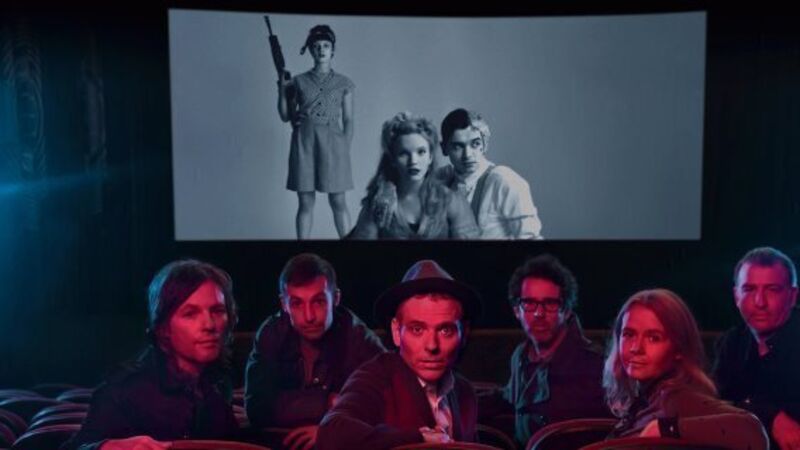Belle and Sebastian screening out those haters

IF YOU know Belle and Sebastian by reputation alone, mere mention of their name may be enough to set your eyes rolling. In popular consciousness, the Glasgow band are the evolutionary dead-end of self-satisfied indie-pop , so ragingly smug as to be indigestible by anyone who doesn’t source their clothing exclusively at charity stores and wear different shades of Chuck Converse runner every day.
In fact, their status as the six-headed Wes Anderson of alternative rock is ill-deserved. Far from sugary and self-satisfied, Belle and Sebastian at their finest radiate heart-breaking beauty. Think of them as The Smiths’ unencumbered by Morrissey’s vast ego: this is music for (and possibly by) underdogs — exquisitely bitter-sweet and, should you belong to their tribe, possibly life-changing.
Still, perceptions are hard to shift and, as the group count down to their ninth studio album, Girls In Peacetime Want To Dance, they are aware that their image is, if not exactly tarnished, then wildly distorted among the wider public.
“More than The Smiths, more than Nirvana, Belle and Sebastian — with its Glaswegian jingle-jangle and wry depressive undertow — is the folk music of twee,” wrote the Atlantic Monthly in a July 2014 article entitled ‘The Twee Revolution’.
Belle and Sebastian, the piece continued, stood alongside actress Zooey Deschanel, author Jonathan Safran Foer and aforementioned movie director Wes Anderson as figureheads of a cultural movement to be resisted at all costs, one that involved “the utter dispensing with of ‘cool’ as it’s conventionally known, often in favor of a kind of fetishization of the nerd, the geek, the dork, the virgin”.
“All of that is external to us – we have no control over it,” sighs keyboardist Chris Geddes. “That idea of who we are doesn’t actually have much to do with what we are like as people. If we are dismissed because of that perception — if it puts potential listeners off — well, then, I don’t know. I’m not clear what we can do about it. It is what it is.”
It’s nearly five years since Belle and Sebastian’s last record, Write About Love, and Geddes wasn’t always sure there would be another. In 2011, songwriter Stuart Murdoch went off to direct a movie: unspoken was the fact that Belle and Sebastian would then be on leave of absence.
As the hiatus lengthened the rest of the line-up wondered whether that might not be that: not every band breaks up in a blazing row, some fall apart incrementally. Could Belle and Sebastian suffer just such a fate? It seemed distinctly possible.
By the time Murdoch reconvened B&S in 2013 for an American tour, they were already down a member. With a young family, trumpeter Mick Cooke announced he was stepping aside. He loved Belle and Sebastian but didn’t wish to go on. This was more serious than might first appear: Cook’s heartfelt playing was a feature of many of the group’s most fondly regarded tunes. Without him the project risked being significantly diminished.
Then, it wasn’t the first occasion they’d lost a supposedly key constituent. In the late 1990s, Belle and Sebastian had to deal with the departure in short order of founder member Stuart David and singer/ cellist Isobel Campbell. As with Cooke’s exit, people wondered how they could possibly go on. Somehow they found a way.
“In the first couple of years, it would have been unthinkable to continue without Stuart David or Isobel,” says Geddes. “It gets to the point where somebody doesn’t want to do it any more. However, if the remainder want to go on… well, then you do. It’s the advantage of having so many members. You can shed one or two.”
It is somewhat of a surprise that Geddes has consented to an interview. For most of their history, Belle and Sebastian were a band for whom the term ‘media shy’ might have been created. They felt their reticence was justified: through his 20s and 30s, Stuart Murdoch suffered chronic fatigue syndrome, or ME, and was reluctant to field endless questions about his illness from nosy journalists (a recent relapse inspired the most confessional tune on the new LP, ‘Nobody’s Emperor’).
As a young man, it appeared ill health might be the defining feature of his life. He was incapacitated for two years and spent another five recovering. During the latter period Murdoch wrote his first song: shortly afterwards, he signed up to a music-production course in Glasgow, where, as a class project, he recorded an entire LP, later released as Belle and Sebastian’s debut, Tigermilk.
That record contained one of the group’s singular songs, the synth-driven ‘Electronic Renaissance’. With Girls In Peacetime, there’s a sense of coming full circle, as it marks the first occasion since Tigermilk that Belle and Sebastian have employed keyboards and synthetic beats so explicitly.
“Stuart did Electronic Renaissance entirely on his own,” says Geddes. “This time, it was a band effort. We are big fans of the Pet Shop Boys — of their songs and their live sensibility. With this new album, there is a feeling of change, as well. In a way we were forced into it, because Mick had left. We recruited a bass-player in his place. The new line-up made things feel fresh for us.”
It was the departed trumpeter who was most unhappy with Belle and Sebastian’s pigeonholing as sultans of twee. The rest of the group have made peace with their place in underdog culture, somewhere between Hatful of Hollow and The Royal Tenenbaums.
“The people at our gigs seem a lot like us,” says Geddes. “We feel we have a great deal in common with our audience. We are aware we have a certain image. We also know that’s not who we really are.”












